Comparison of Distribution and Density of Nemopilema nomurai by Water Columns Using Echo Counting and Echo Integration Methods
Abstract
1. Introduction
2. Material and Methods
2.1. The Surveyed Area and Date
2.2. Acoustic Equipment System and Data Collection
2.3. Acoustic Data Analysis
3. Results
3.1. Vertical Distribution of N. nomurai
3.2. Horizontal Distribution of N. nomurai in Survey Area
3.3. Correlation of NASC of N. nomurai by Analysis Methods
4. Discussion
5. Conclusions
Author Contributions
Funding
Acknowledgments
Conflicts of Interest
References
- Lee, Y.W.; Hwang, B.K. Theoretical examination of the effects of fluctuation of acoustic scattering on the swimming behavior of giant jellyfish. Korean J. Fish. Aquat. Sci. 2009, 42, 165–170. [Google Scholar] [CrossRef]
- Yoon, E.A.; Cha, C.P.; Hwang, D.J.; Yoon, Y.H.; Shin, H.H.; Gwak, D.S. Inter-annual occurrence variation of the large jellyfish Nemopilema nomurai due to the changing marine environment in the East China Sea. J. Korean Soc. Fish. Ocean Technol. 2012, 48, 242–255. [Google Scholar] [CrossRef]
- Lee, K.H.; Kim, I.O.; Yoon, W.D.; Shin, J.K.; An, H.C. A study on vertical distribution observation of giant jellyfish (Nemopilema nomurai) using acoustical and optical methods. J. Korean Soc. Fish. Ocean Technol. 2007, 43, 355–361. [Google Scholar] [CrossRef][Green Version]
- Park, S.W.; Lee, K.H.; Yoon, W.D.; Lee, D.G.; Kim, S.H.; Yang, Y.S.; Lee, G.H. A Study on the Damage Reduction Strategy Against a Harmful Aquatic Organism, Jellyfish’s Bloom. J. Fish. Mar. Sci. Educ. 2015, 27, 49–62. [Google Scholar]
- Lee, D.G.; Han, I.W.; Chae, J.H.; Yoon, W.D.; Yang, Y.S.; Kim, D.H.; Lee, K.H. Analysis of the Advantage and Disadvantage of Harmful Jellyfish’s Damage Reduction Devices Strategy Types in the Beach. J. Korean Soc. Fish. Mar. Educ. 2019, 31, 1230–1241. [Google Scholar]
- Kang, D.H.; Lee, C.W.; Lee, H.B.; Kim, M.R. Measurements of sound speed and density contrasts of the moon jellyfish (Aurelia aurita sl) for Hydroacoustic Model. Ocean Polar Res. 2012, 34, 85–91. [Google Scholar] [CrossRef]
- Hirose, M.; Mukai, T.; Shimura, T.; Yamamoto, J.; Iida, K. Measurements of specific density of and sound speed in Nomura’s jellyfish Nemopilema nomurai to estimate their target strength using a theoretical scattering model. J. Mar. Acoust. Soc. Jpn. 2007, 342, 109–118. [Google Scholar] [CrossRef]
- Uye, S.I. Blooms of the giant jellyfish Nemopilema nomurai: A threat to the fisheries sustainability of the East Asian Marginal Seas. Plankton Benthos Res. 2008, 3, 125–131. [Google Scholar] [CrossRef]
- Trout, E.D.; Kelley, J.P.; Cathey, G.A. The use of filters to control radiation exposure to the patient in diagnostic roentgenology. Am. J. Roentgenol. Radium Ther. Nucl. Med. 1952, 67, 946–963. [Google Scholar]
- Hirose, M.; Mukai, T.; Hwang, D.J.; Iida, K. Target strength measurements on tethered live jellyfish Nemopilema nomurai. Bull. Jpn. Soc. Sci. Fish. 2005, 71, 571–577. [Google Scholar] [CrossRef][Green Version]
- Simmonds, J.; MacLennan, D.N. Fisheries Acoustics: Theory and Practice; Blackwell Science: Oxford, UK, 2005; pp. 104–201. [Google Scholar]
- Shin, H.H.; Han, I.W.; Oh, W.S.; Chae, J.H.; Yoon, E.A.; Lee, K.H. Estimation of Moon Jellyfish Aurelia coerulea Using Hydroacoustic Methods off the Coast of Tongyeong, Korea. Korean J. Fish. Aquat. Sci. 2019, 52, 725–734. [Google Scholar]
- Yoon, E.A.; Lee, K.; Chae, J.; Yoon, W.; Han, C.; Lee, H.; Oh, W. Density Estimates of Moon Jellyfish (Aurelia coerulea) in the Yeongsan Estuary using Nets and Hydroacoustics. Ocean Sci. J. 2019, 54, 457–465. [Google Scholar] [CrossRef]
- Korneliussen, R.J.; Diner, N.; Ona, E.; Berger, L.; Fernandes, P.G. Proposals for the collection of multifrequency acoustic data. ICES J. Mar. Sci. 2008, 65, 982–994. [Google Scholar] [CrossRef]
- Kim, S.; Lee, K.; Yoon, W.D.; Lee, H.; Hwang, K. Vertical Distribution of Giant Jellyfish, Nemopilema nomurai using Acoustics and Optics. Ocean Sci. J. 2016, 51, 59–65. [Google Scholar] [CrossRef]
- Yoon, E.A.; Hwang, D.J.; Shin, H.H. In situ behavioral and acoustic characteristics of the large jellyfish Nemopilema nomurai by target tracking. J. Korean Soc. Fish. Ocean Technol. 2015, 51, 272–278. [Google Scholar] [CrossRef]
- Malej, A.; Turk, V.; Lucic, D.; Benovic, A. Direct and indirect trophic interactions of Aurelia sp. (Scyphozoa) in a stratified marine environment (Mljet Lakes, Adriatic Sea). Mar. Biol. 2007, 151, 827–841. [Google Scholar] [CrossRef]
- Albert, D.J. Vertical distribution of Aurelia labiata (Scyphozoa) jellyfish in Roscoe Bay is similar during flood and ebb tides. J. Sea Res. 2010, 64, 422–425. [Google Scholar] [CrossRef]
- Hamner, W.M.; Hamner, P.P.; Strand, S.W. Sun-compass migration by Aurelia aurita (Scyphozoa): Population retention and reproduction in Saanich Inlet, British Columbia. Mar. Biol. 1997, 119, 347–356. [Google Scholar] [CrossRef]
- Graham, W.M.; Martin, D.L.; Martin, J.C. In situ quantification and analysis of large jellyfish using a novel video profiler. Mar. Ecol. Prog. Ser. 2003, 254, 129–140. [Google Scholar] [CrossRef]
- Rakow, K.C.; Graham, W.M. Orientation and swimming mechanics by the scyphomedusae Aurelia sp in shear flow. Limnol. Oceanogr. 2006, 51, 1097–1106. [Google Scholar] [CrossRef]
- Han, C.H.; Uye, S.I. Quantification of the abundance and distribution of the common jellyfish Aurelia aurita s.l. with a Dual-frequency IDentification SONar (DIDSON). J. Plankton Res. 2009, 31, 805–814. [Google Scholar] [CrossRef]
- NFRDI. Mass occurrence of jellyfish and its prevention and utilization. Annu. Rep. 2008, 1, 19–26. [Google Scholar]
- Ortner, P.B.; Cummings, S.R.; Aftring, R.P.; Edgerton, H.E. Silhouette photography of oceanic zooplankton. Nature 1979, 277, 50–51. [Google Scholar] [CrossRef]
- Strickler, J.R. Observations of swimming performances of planktonic copepods. Limnol. Oceanogr. 1997, 22, 165–170. [Google Scholar] [CrossRef]
- Price, H.J. Swimming behavior of krill in response to algal patches: A mesocosm study. Limnol. Oceanogr. 1989, 34, 649–659. [Google Scholar] [CrossRef]
- Davis, C.S.; Gallager, S.M.; Solow, A.R. Microaggregations of oceanic plankton observed by towed video microscopy. Science 1992, 257, 230–232. [Google Scholar] [CrossRef]
- Mano, T.; Guo, X.; Fujii, N.; Yoshie, N.; Tsutsumi, E.; Saito, R. Moon jellyfish aggregations observed by a scientific echo sounder and an underwater video camera and their relation to internal waves. J. Oceanogr. 2019, 75, 359–374. [Google Scholar] [CrossRef]
- Honda, N.; Watanabe, T. Observation of the giant jellyfish Nemopilema nomurai using an underwater acoustic camera. Nippon Suisan Gakkaishi 2007, 73, 919–921. [Google Scholar] [CrossRef]
- Yang, Y.S.; Bae, J.H.; Lee, K.; Park, J.S.; Sohn, B.K. Fish monitoring through a fish run on the Nakdong River using an acoustic camera system. Korean J. Fish. Aquat. Sci. 2010, 43, 735–739. [Google Scholar]
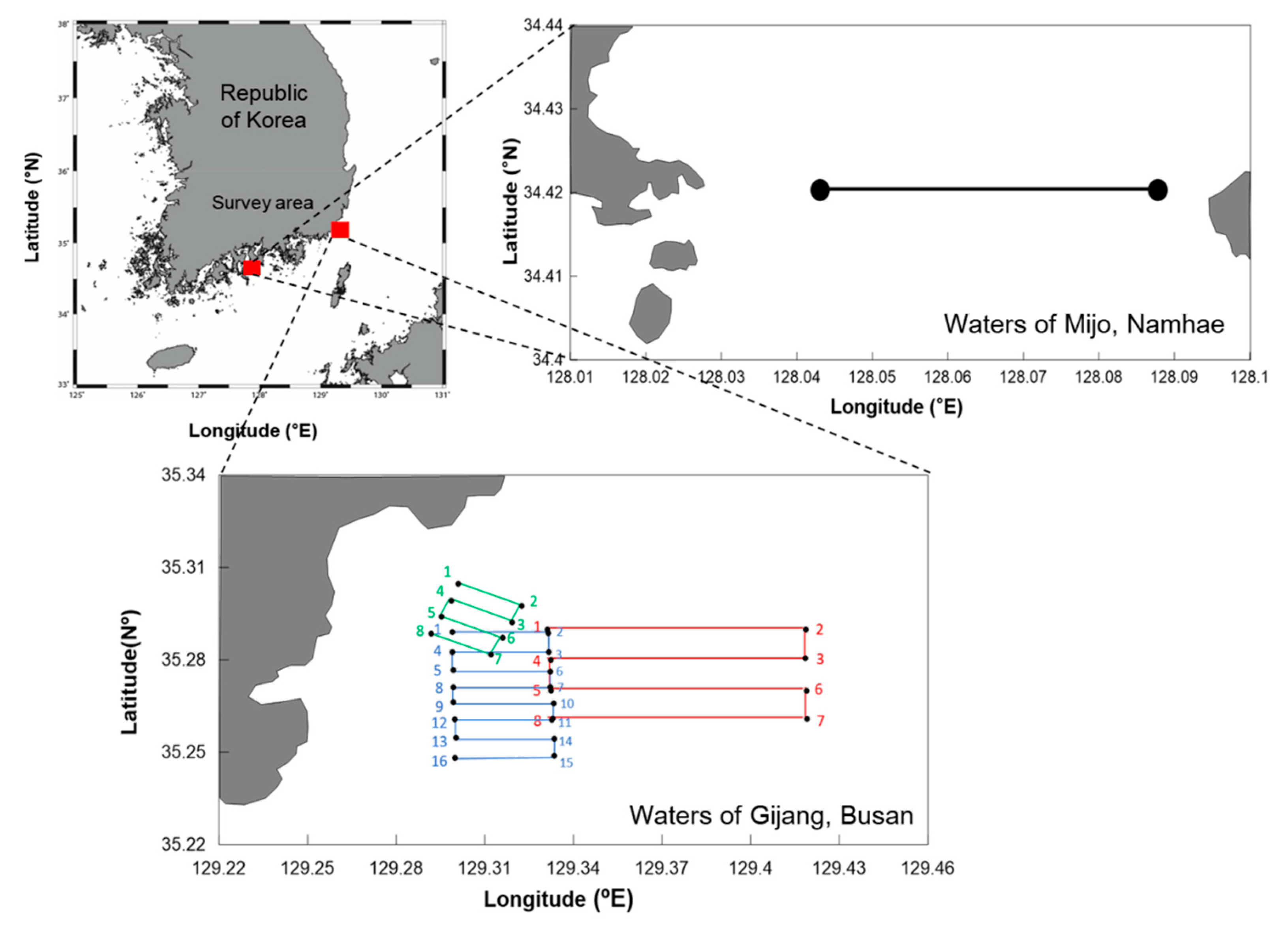
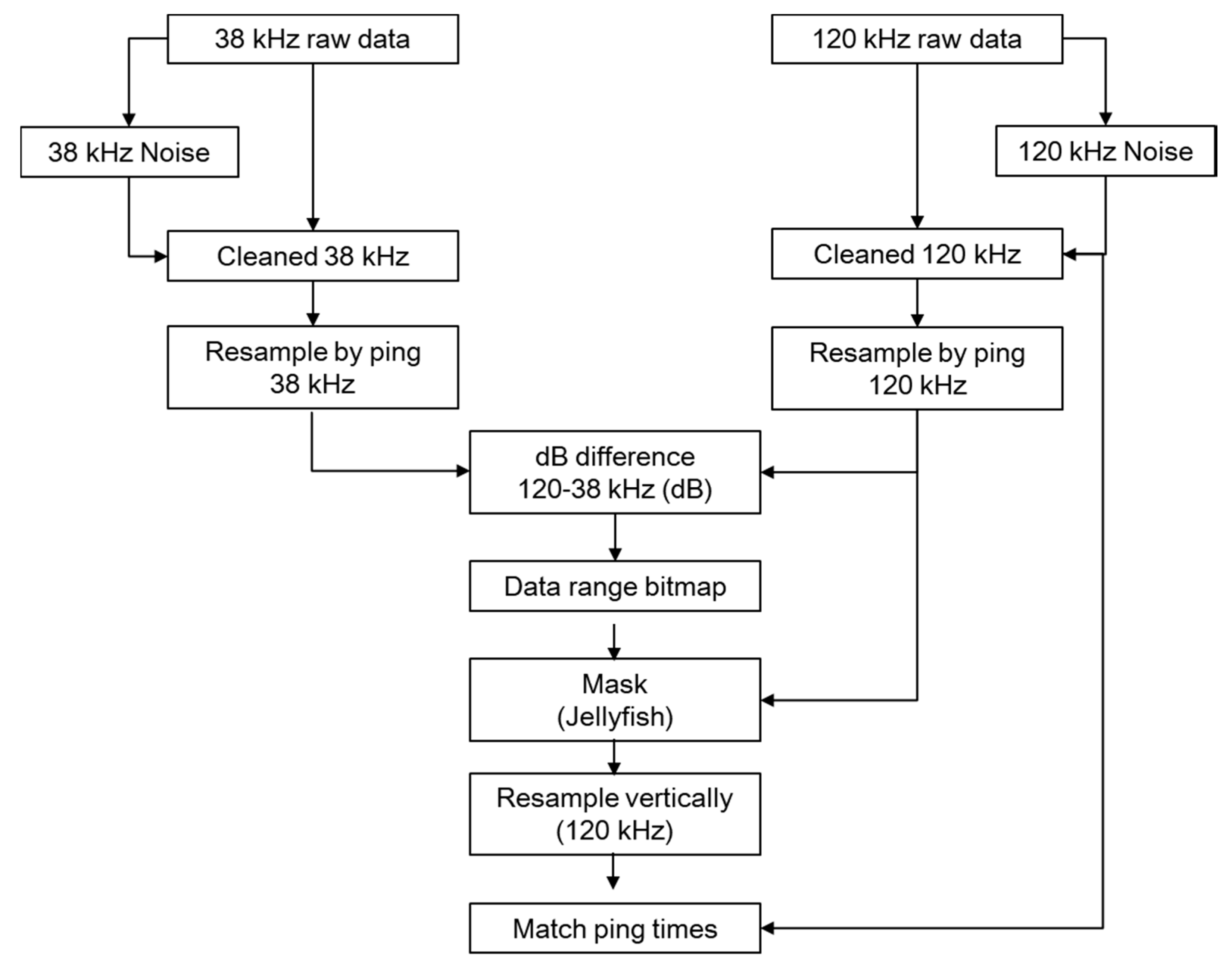

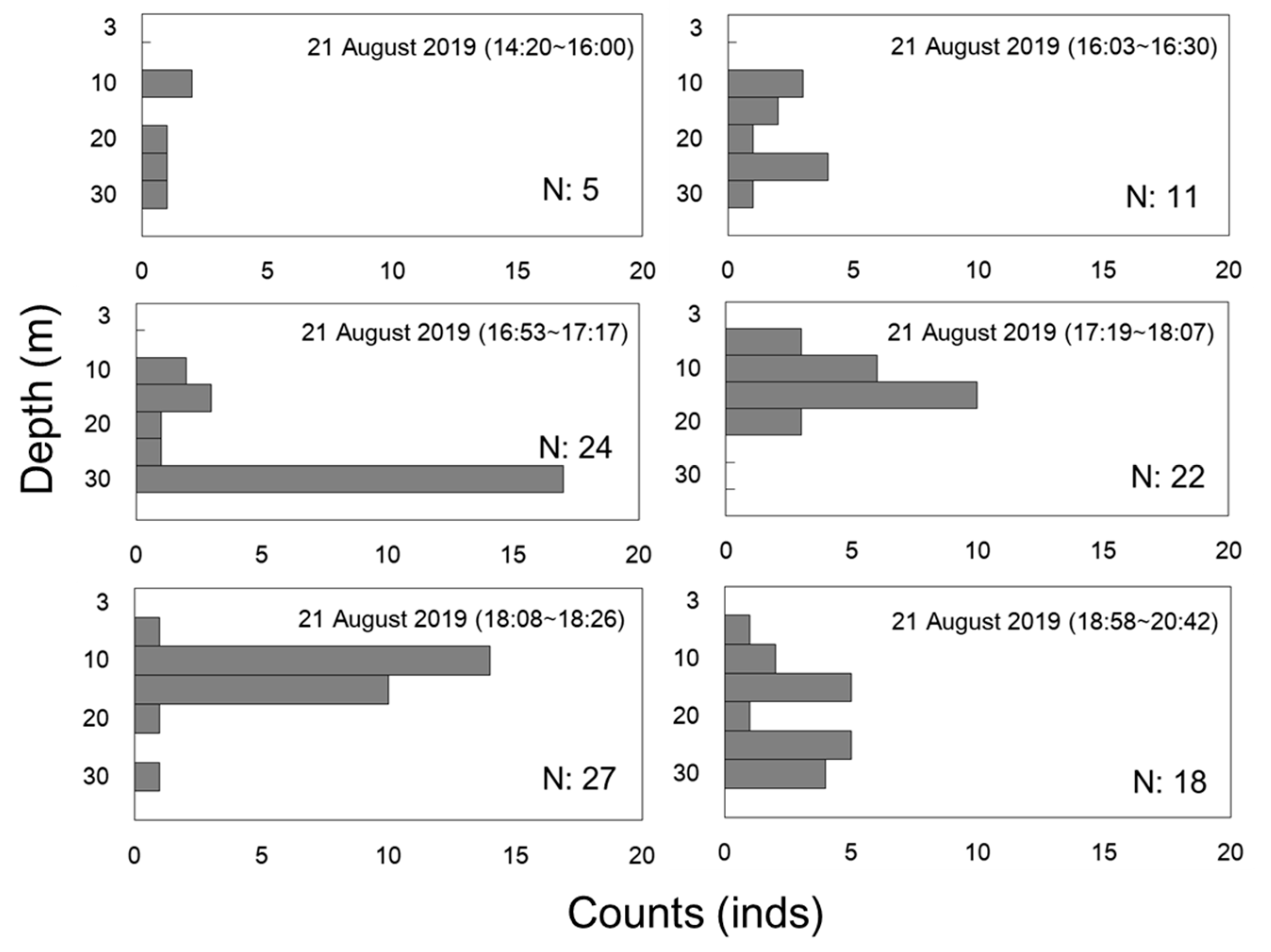
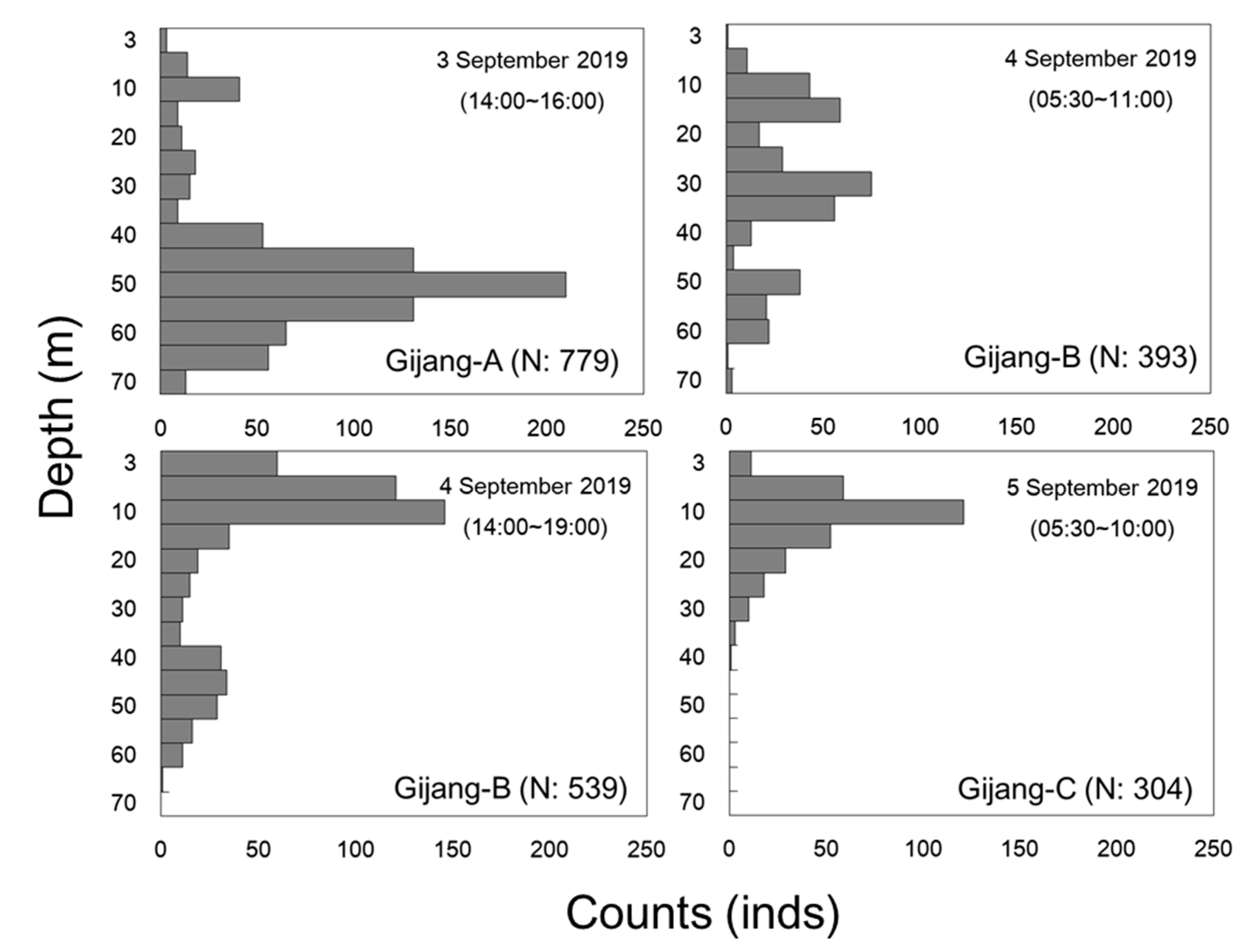
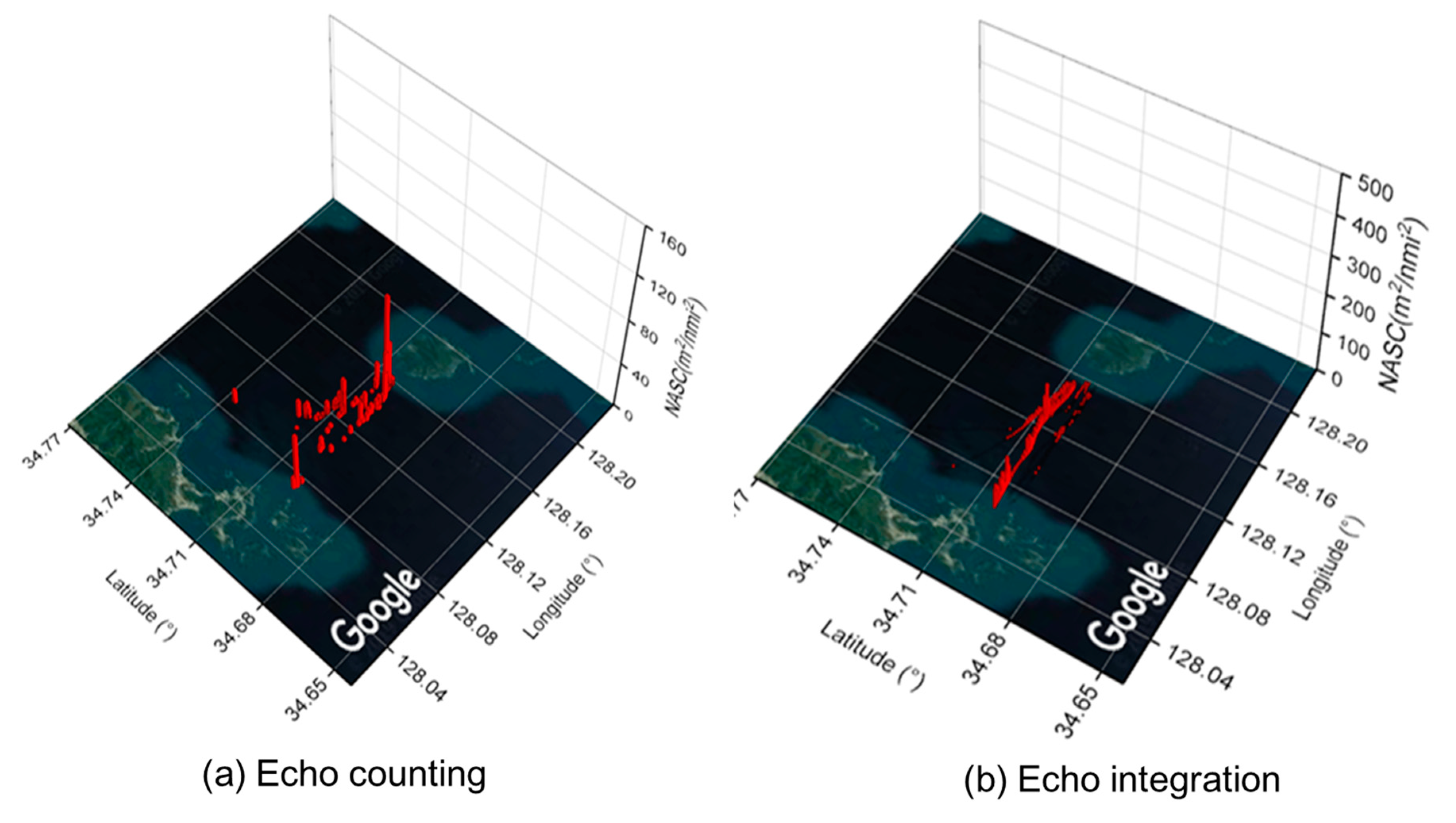
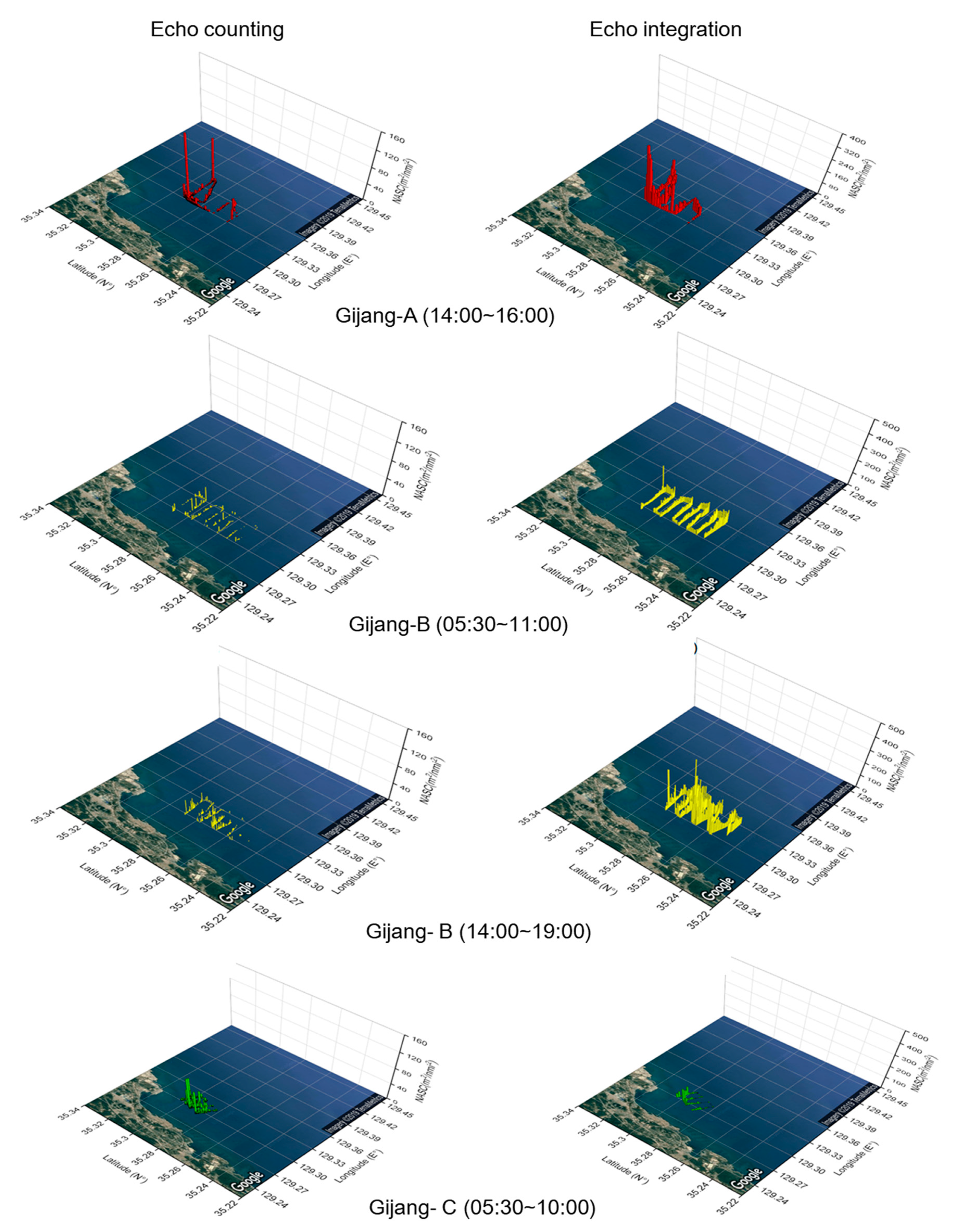
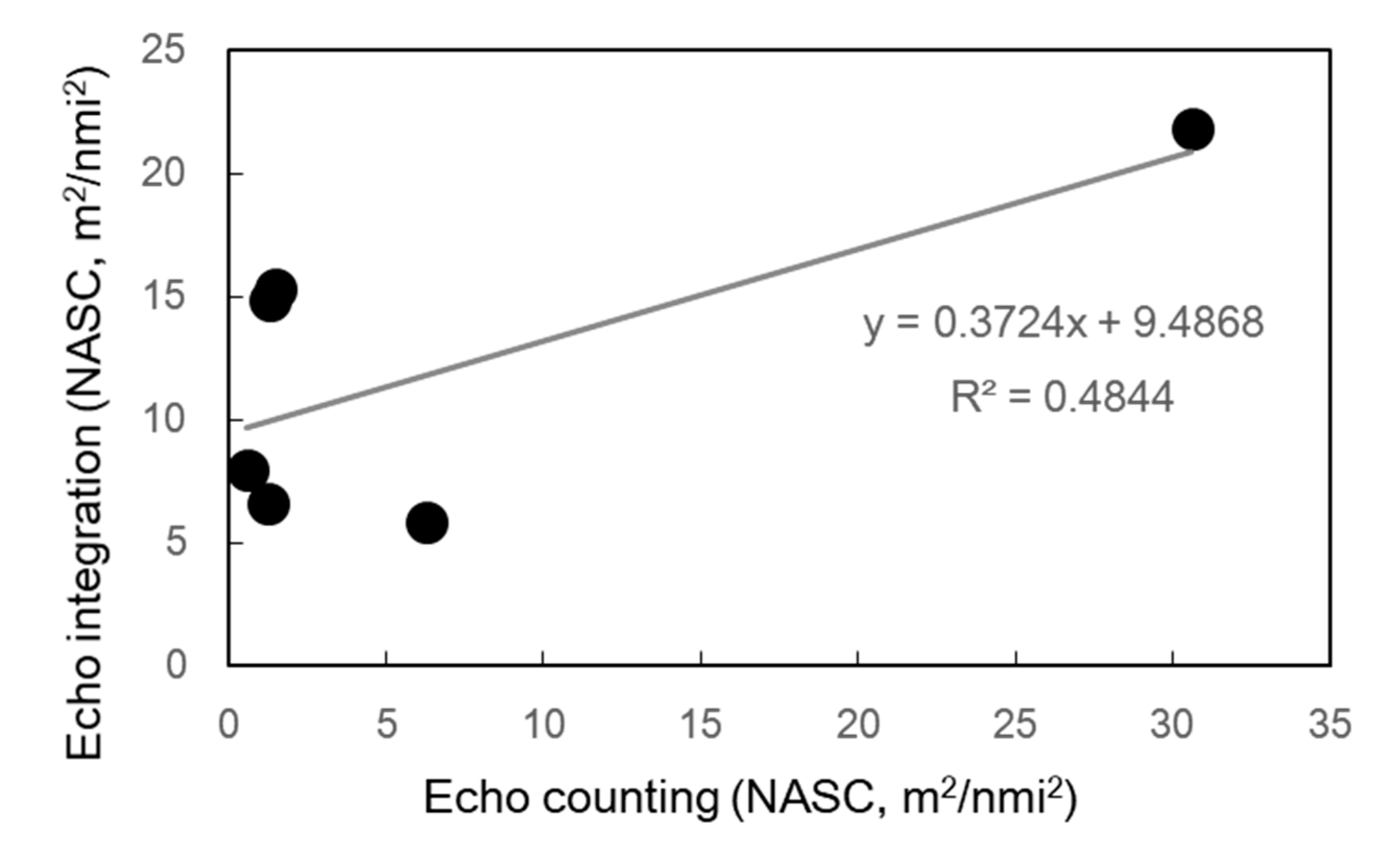

| Area | Date (Time) | Line Length (km) | Survey Area (km2) |
|---|---|---|---|
| Namhae | 21 August 2019 (14:00–20:00) | 8 | 20 |
| Gijang-A | 3 September 2019 (14:00–16:00) | 22.2 | 25.3 |
| Gijang-B | 4 September 2019 (05:30–11:00/14:00–19:00) | 15.0 | 13.5 |
| Gijang-C | 5 September 2019 (05:30–10:00) | 8.1 | 4.1 |
| Parameters | 38 kHz | 120 kHz |
|---|---|---|
| Two-way beam angle (dB) | −15.5 | −21.0 |
| Transducer gain (dB) | 21.5 | 27.0 |
| 3-dB beam angle (athwart/along) (°) | 11.82/12.15 | 6.35/6.37 |
| Absorption coefficient (dB m−1) | 0.0065024 | 0.0405578 |
| Sound speed (m s−1) | 1523.09 | 1523.09 |
| Power (W) | 1000 | 250 |
| Pulse length (ms) | 1.024 | 1.024 |
| No. | Time | Count (inds) | Distance (m) | Density (10−4 ind/m) |
|---|---|---|---|---|
| 1 | 14:40–16:00 | 5 | 8000 | 6.25 |
| 2 | 16:03–16:30 | 11 | 8000 | 13.75 |
| 3 | 16:53–17:17 | 24 | 8000 | 30.00 |
| 4 | 17:19–18.07 | 22 | 8000 | 27.50 |
| 5 | 18:08–18:26 | 27 | 8000 | 33.75 |
| 6 | 18:58–20:42 | 18 | 8000 | 22.50 |
| Avg. | 17.83 | 22.29 |
| Survey Line | Gijang-A (14:00–19:00) | Gijang-B (05:30–11:00) | Gijang-B (14:00–19:00) | Gijang-C (05:30–10:00) | ||||||||
|---|---|---|---|---|---|---|---|---|---|---|---|---|
| Count (inds) | Distance (m) | Density (10−4 ind/m) | Count (inds) | Distance (m) | Density (10−4 ind/m) | Count (inds) | Distance (m) | Density (10−4 ind/m) | Count (inds) | Distance (m) | Density (10−4 ind/m) | |
| 1 | 161 | 8008 | 201.05 | 72 | 2967 | 242.67 | 97 | 2967 | 326.93 | 96 | 2114 | 454.12 |
| 2 | 238 | 7889 | 301.69 | 103 | 2990 | 344.48 | 58 | 2990 | 193.98 | 60 | 2021 | 296.88 |
| 3 | 354 | 7933 | 446.24 | 59 | 2987 | 197.52 | 146 | 2987 | 488.78 | 91 | 2038 | 446.52 |
| 4 | 26 | 7920 | 32.83 | 46 | 3020 | 152.32 | 81 | 3020 | 268.21 | 57 | 2000 | 285.00 |
| 5 | - | - | - | 21 | 3111 | 67.50 | 72 | 3111 | 231.44 | - | - | - |
| 6 | - | - | - | 48 | 3026 | 158.63 | 46 | 3026 | 152.02 | - | - | - |
| 7 | - | - | - | 30 | 3050 | 98.36 | 33 | 3050 | 108.20 | - | - | - |
| 8 | - | - | - | 14 | 3073 | 45.56 | 6 | 3073 | 19.52 | - | - | - |
| Avg. | 245.45 | 163.38 | 223.64 | 370.63 | ||||||||
© 2020 by the authors. Licensee MDPI, Basel, Switzerland. This article is an open access article distributed under the terms and conditions of the Creative Commons Attribution (CC BY) license (http://creativecommons.org/licenses/by/4.0/).
Share and Cite
Kim, K.Y.; Lim, W.A.; Chae, J.; Sung, G.; Oh, W.; Lee, K. Comparison of Distribution and Density of Nemopilema nomurai by Water Columns Using Echo Counting and Echo Integration Methods. Sustainability 2020, 12, 5823. https://doi.org/10.3390/su12145823
Kim KY, Lim WA, Chae J, Sung G, Oh W, Lee K. Comparison of Distribution and Density of Nemopilema nomurai by Water Columns Using Echo Counting and Echo Integration Methods. Sustainability. 2020; 12(14):5823. https://doi.org/10.3390/su12145823
Chicago/Turabian StyleKim, Kyoung Yeon, Weol Ae Lim, Jinho Chae, Gunhee Sung, Wooseok Oh, and Kyounghoon Lee. 2020. "Comparison of Distribution and Density of Nemopilema nomurai by Water Columns Using Echo Counting and Echo Integration Methods" Sustainability 12, no. 14: 5823. https://doi.org/10.3390/su12145823
APA StyleKim, K. Y., Lim, W. A., Chae, J., Sung, G., Oh, W., & Lee, K. (2020). Comparison of Distribution and Density of Nemopilema nomurai by Water Columns Using Echo Counting and Echo Integration Methods. Sustainability, 12(14), 5823. https://doi.org/10.3390/su12145823





